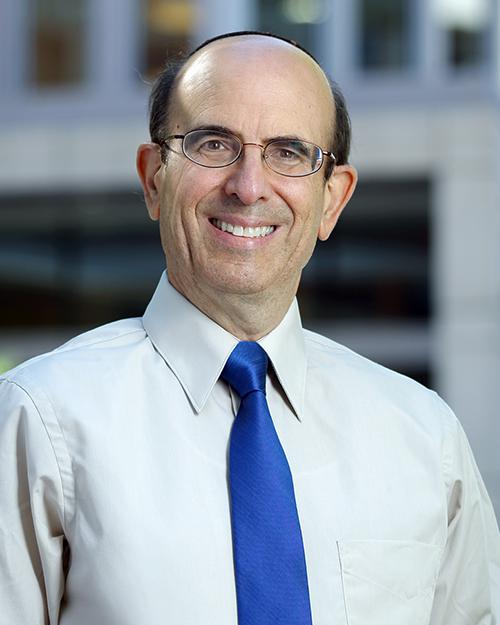
Alan David Friedman, MD
Leukemia
Highlights
Johns Hopkins Affiliations:
- Johns Hopkins School of Medicine Faculty
About Alan David Friedman
Professional Titles
- King Fahd Professor of Pediatric Oncology
Primary Academic Title
Professor of Oncology
Johns Hopkins Physician

Background
Dr. Friedman is the King Fahd Professor of Oncology and Professor of Pediatrics at the Johns Hopkins University School of Medicine and a member of the Johns Hopkins Kimmel Cancer Center. He received his M.D. from the Harvard Medical School (1983), did his pediatric internship and residency at Boston Children's Hospital (1983-86), and completed a fellowship in pediatric hematology-oncology at Johns Hopkins (1986-89). As a fellow, he did post-doctoral research at the Carnegie Institution Department of Embryology located on the Johns Hopkins Homewood campus. Dr. Friedman has served on the Pediatric Oncology faculty at Johns Hopkins since 1989. His laboratory focuses on investigation of normal and abnormal blood-cell formation. Dr. Friedman also cares for children with cancer, specializing in the treatment of leukemia.
Centers and Institutes
Find a Clinical Trial
View all trials by this principal investigator.
Additional Academic Titles
Professor of Pediatrics
Research Interests
Regulation of Myeloid Differentiation and Transformation
Research Summary
RUNX1 is a transcription factor required for the formation of the hematopoietic stem cell (HSC) and for its further maturation. RUNX1 is commonly mutated or involved in chromosomal translocations associated with AML or ALL. Dr. Friedman''s laboratory is investigating the mechanisms that allow RUNX1 to regulate normal hematopoietic stem cells and myeloid differentiation and to stimulate cell cycle progression. He ultimately envisions developing means to manipulate RUNX1 to assist formation and expansion of HSC from embryonic stem cells and to assist formation of autologous neutrophils to benefit patients with neutropenia. In addition, Dr. Friedman is investigating how mutations of RUNX1 or its partner CBFb contribute to acute leukemia, focusing on CBFb-SMMHC, a fusion oncoprotein expressed from the inv(16) chromosome in a subset of AML patients. Ultimately, he would like to identify small molecules that target CBFb-SMMHC to assist in the therapy of AML.
C/EBPa is a transcription factor required for formation of normal neutrophils and monocytes. C/EBPa is also commonly mutated in blasts derived from patients with AML. Dr. Friedman''s laboratory is investigating how C/EBPa cooperates with other proteins, including cytokines such as G-CSF or M-CSF, to control normal myeloid development. In addition, he is investigating how mutant forms of C/EBPa contribute to AML, in particular focusing on how interaction between C/EBPa and another transcription factor, NF-kB, inhibits apoptosis. By mapping the amino acids through which these proteins interact, Dr. Friedman hopes to ultimately design small molecules that prevent their interaction to induce leukemic cell death and contribute to the therapy of AML. As C/EBPs and NF-kB are also expressed also in other malignancies and in inflammatory cells which contribute to cancer formation and progression, such a small molecule might in addition have broader utility as a novel therapeutic.
Selected Publications
Cai DH, Wang D, Keefer J, Yeamans C, Hensley K, Friedman AD. C/EBP?:AP-1 Leucine Zipper Heterodimers Bind Novel DNA Element, Activate the PU.1 Promoter, and Direct Monocyte Lineage Commitment More Potently Than C/EBP? Homodimers or AP-1.Oncogene 2008; 27(19):2772-9.
Guo H, Cooper S, Friedman AD. In Vivo Deletion of the +37 kb Cebpa Enhancer Markedly Reduces Cebpa mRNA in Myeloid Progenitors but Not in Non-Hematopoietic Tissues to Impair Granulopoiesis. PLoS One 2016; 11(3):e0150809.
Kummalue T, Lou J, Friedman AD. Multimerization via its Myosin Domain is a Prerequisite for Inhibition of CBF Activities by the CBF?-SMMHC Myeloid Leukemia Oncoprotein. Mol. Cell. Biol. 2002; 22(23):8278-91.
Leong WY, Guo H, Ma O, Huang H, Cantor AB, Friedman AD. Runx1 Phosphorylation by Src Increases Trans-Activation via Augmented Stability, Reduced Histone Deacetylase (HDAC) Binding, and Increased DNA Affinity, and Activated Runx1 Favors Granulopoiesis. J. Biol. Chem. 2016; 291(2):826-36.
Nuchprayoon I, Meyers S, Scott LM, Suzow J, Hiebert S, Friedman AD. PEBP2/CBF, The Murine Homolog of the Human Myeloid Proto-oncogenes AML1 and PEBP2?/CBF?, Regulates the Murine Myeloperoxidase and Neutrophil Elastase Genes in Immature Myeloid Cells. Mol. Cell. Biol. 1994; 14(8):5558-68.
Honors
- Oncology Center Director's Teaching Award in Basic Science, Johns Hopkins University, 1/1/04
- Stohlman Scholar, Leukemia and Lymphoma Society, 1/1/03
- Scholar Award, Leukemia and Lymphoma Society, 1/1/98
- Searle Scholar Award, Chicago Community Trust, 1/1/91
- cum laude, Harvard Medical School, 1/1/83
- Biochemistry Department Award, University of California, Berkeley, 1/1/79
Memberships
- American Academy of Pediatrics
- American Association for the Advancement of Science
- American Society of Hematology
- American Society of Pediatric Hematology-Oncology
- Pediatric Oncology Group/Children''s Oncology Group
Locations
- Johns Hopkins Children's Center
- 1800 Orleans Street, Bloomberg 11N, Baltimore, MD 21287
- phone: 410-955-8751
- fax: 410-614-1802
Expertise
Education
Johns Hopkins University School of Medicine
Fellowship, Pediatric Hematology-Oncology, 1989Boston Children's Hospital
Residency, Pediatrics, 1986Harvard Medical School
Medical Education, MD, 1983Board Certifications
Pediatric Hematology-Oncology
American Board of Pediatrics, 1990Pediatrics
American Board of Pediatrics, 1987Insurance
- Aetna
- CareFirst
- Cigna
- First Health
- Geisinger Health Plan
- HealthSmart/Accel
- Humana
- Johns Hopkins Health Plans
- MultiPlan
- Pennsylvania's Preferred Health Networks (PPHN)
- Point Comfort Underwriters
- Private Healthcare Systems (PHCS)
- UnitedHealthcare
- Veteran Affairs Community Care Network (Optum-VACCN)
